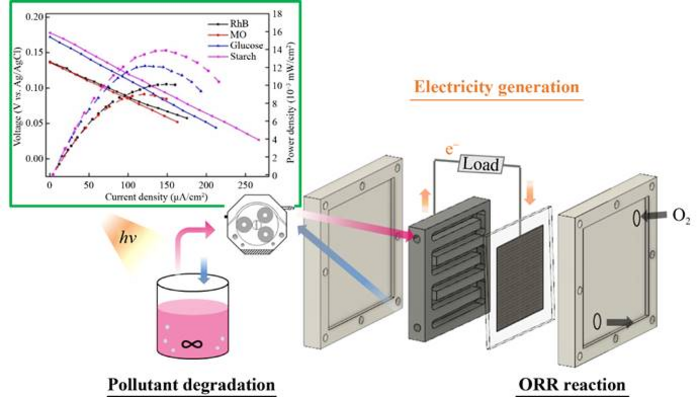Currently, there is a growing demand for the development of sustainable and renewable energy technologies owing to the growing concerns about environmental degradation and energy scarcity. Energy extraction from wastewater has been actively researched over the last few decades to develop effective energy conversion methods.

Image Credit: Yujun Zhou, Qinghua Ji, Chengzhi Hu, Huijuan Liu, Jiuhui Qu
Using complex organic contaminants in wastewater as carbon and energy sources for power generation, creating electricity while degrading the pollutants requires more than three times the energy required to remediate them.
In comparison to Microbial fuel cells (MFC), proton exchange membrane fuel cells (PEMFC), solar-driven power extraction from salinity gradient, and galvanic cells, photocatalytic fuel cell (PFC) is a more prevalent design technique for successfully harvesting energy from wastewater.
Under light irradiation, rapid creation of electron/hole pairs would occur at the photoanode in the PFC system, resulting in a quick and direct charge transfer. Photogenerated holes oxidize and degrade pollutants, while photogenerated electrons at the anode can flow through the external circuit to the cathode for electricity production. Photoanodes directly influence the efficiency of photocatalytic pollutant degradation and electricity generation.
BiOCl is a potential photoanode material because of its unusual layered structure, which considerably enhances the separation and migration of photogenerated electron-hole pairs, and it has been extensively used in the degradation of various refractory organic contaminants in wastewater.
Polyoxometalates are thought to be efficient electron buffers, capturing and storing many electrons per molecule. Their distinct charge transfer capabilities can aid in photocatalytic pollutant degradation. To address the issue, isolated photogenerated electrons generated by composite BiOCl-based catalysts must be briefly held and transferred to the cathode with little loss.
As a result, the fabrication of BiOCl/POMs composites was examined to see if combining the benefits of both may enhance the electron transfer and charge separation capabilities for pollutant degradation and synchronous power generation.
Experts from the Research Center for Eco-Environmental Sciences and Tsinghua University School of Environment created a unique photocatalytic hybrid fuel cell with flow-through field using BiOCl-NH4PTA as a photocatalyst paired with an air cathode (F-HFC).
Their efforts were successful in eliminating organic contaminants from water and generating synchronous electricity. The mechanism of F-HFC has been thoroughly elucidated, providing a critical theoretical foundation for water purification and wastewater energy recovery. The research was published in the Frontiers of Environmental Science & Engineering.
The researchers discovered that dyes and biomass might be directly degraded in F-HFC, resulting in improved pollutant degradation and electricity generation. Within 90 minutes of irradiation, nearly all of the dyes could be eliminated. The photocatalyst BiOCl-NH4PTA significantly increased electron transport and charge separation.
They discovered that the BiOCl-NH4PTA composite has improved photocatalytic oxidation ability over contaminants as well as power outputs when compared to pure BiOCl photocatalysts.
Furthermore, the generator theory of the F-HFC system was clarified. Their research found that polyoxometalate (NH4PTA) acts as a photoelectronic acceptor and can slow the recombination of photogenerated electrons and holes, resulting in improved photocatalytic degradation.
The research successfully created an electron and mass transfer enhanced photocatalytic hybrid fuel cell with flow-through field (F-HFC) using BiOCl-NH4PTA photocatalysts and a Pt/C air-cathode. This study not only expands the design of high-performance photocatalysts combined with flow-through field fuel cell systems, but it also gives novel methods for the treatment of refractory wastewater and concurrent energy recovery.
Journal Reference
Zhou, Y., et al. (2022). A hybrid fuel cell for water purification and simultaneously electricity generation. Frontiers of Environmental Science & Engineering. doi.org/10.1007/s11783-023-1611-6.